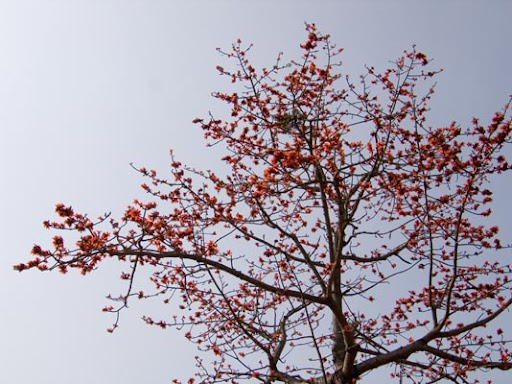The King of the Forest

When we recently visited the Jaldapara wildlife sanctuary, we noted the large number of Simul trees that dot the forest. The simul is my favourite tree. For most of the year it arises majestically full of leaves and gives plenty of shade. Anybody who has walked in the forests of Purulia will remember how welcome its shade can be after a long walk. Come spring, however, it loses its leaves and becomes full of a mass of crimson coloured flowers. The transition is sudden and the flowers bloom lighting up the forest or the garden. These trees tend to grow in clusters all of whom bloom together so that a patch of forest may turn red when they flower. The flowers also fall below the tree and turn a patch of grass into a red carpet that is a sight that is ethereal.
The trees are tall and majestic and the trunk is studded with spike like projections. There is a story current in Oriya tribal lore about how the tree got these projections. A tribal king chased a demon onto the tree. As he climbed the demon ripped off his teeth and left them studded along the trunk of the tree. The king was unable to pursue him up the tree and the demon thus made good his escape. He left behind however the spikes that make climbing a simul tree hazardous. This tree is native to our country and has been associated with many tribal customs from time immemorial. For instance, Murias, a tribal group in Madhya Pradesh, always plant a simul tree at the centre of the village. This tree is then central to all tribal ceremonies including that of marriage.
Scientifically they are named Bombax ceiba. Bombax malabaricum is sometimes used as a synonym. The wood of the tree is soft and not useful for furniture but has been used to make toys and floats for fishermen. A little after the flowering is over the trees give rise to the cotton from which it gets its name. Tufts of cotton float down and fly in the breeze. However this cotton is not suitable for spinning, but villagers use it to stuff pillows. But the tree is a haven for birds especially when it is in full bloom. To watch birds, just park yourself near a red silk cotton in bloom and I have sometimes spent hours watching the different types of birds enjoying the food supply that it provides. At any given morning you can be fairly sure to see at least five different species visiting the tree.
I love walking in forests. One of the principal pleasures of such walks is of course the flowering trees. The red silk cotton is one tree that can really lift your spirits. If you see it during the spring, when it flowers so majestically, you will never forget its splendour. Fortunately it is still very common and can still be seen fairly often in and around Siliguri. The adjacent forests are of course full of them. To my mind they are one of the kings of the Indian forest.
(The picture is borrowed from the net; it demonstrates exactly what I said about the Bombax In bloom)



Comments